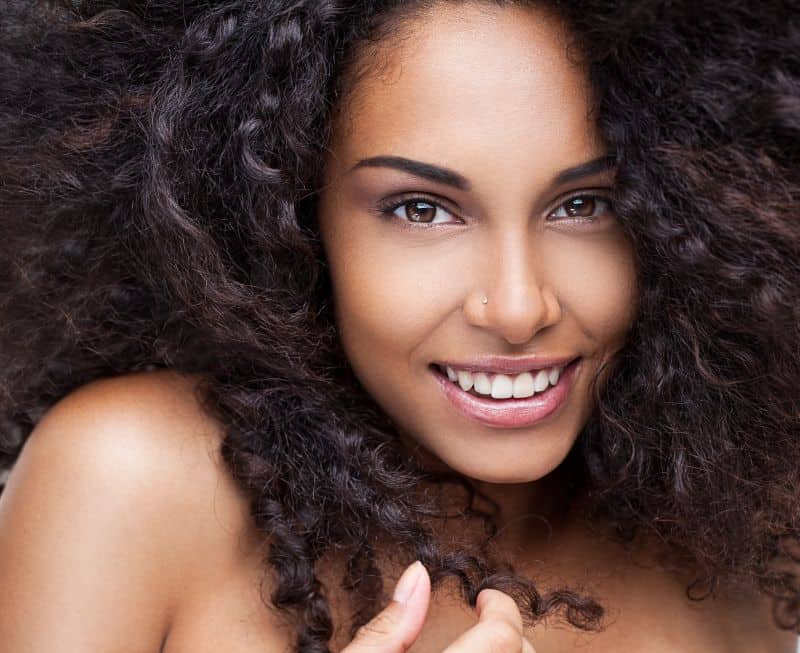Last Updated on December 18, 2022 by Vera Aduongo
Written by Vera AduongoHere’s the Full Low-Down on Why Protein Treatments for Natural Hair
Your hair is made up of many things, and one of them is protein. In fact, 95% of your hair is made out of a protein called keratin. So to say that protein is important for your hair is an understatement. It is absolutely crucial! The protein in your diet gets processed to make keratin, which makes your hair grow longer and stay strong.
However, certain hairstyling practices can damage our hair by interfering with the proteins in our hair. Bleaching, dyeing, excessive heat styling, relaxing and texturizing are all practices that can weaken the hair. There’s also the general wear-and-tear that can happen to our ends as our hair ages. Luckily, you can use protein treatments to help you remedy these situations temporarily.
So today, we’re going to talk about protein treatments: how they work, how to do them, and give you some recommendations on the best treatment products you can try on your hair.

How Does a Protein Treatment Work?
This can get really technical, really quick, so allow us to use an analogy to explain. Let’s say you have a brick wall, and a storm comes around and damages sections of the brick wall so that some of the bricks are missing. How would you repair that wall? If the damage isn’t too bad, you’d have someone come and replace the bricks that fell out with some new ones. The wall wouldn’t be as good as new, but it would be smoother and stronger, allowing it to do a better job of protecting your property.
Got it? Now, let’s relate this to hair. The brick wall is the outermost layer of your hair called your cuticle. Your cuticle has many sections that overlap just like shingles on a roof do, and these protect the inner structure of your hair from external damage. Just like the damaged brick wall, when the cuticle is damaged, it doesn’t do a good job at protecting what’s inside, and it’s easier for things, including moisture, to easily slip in and out of the inner parts of your hair strand.
A protein treatment is the equivalent of putting in new bricks to replace the ones that were lost. Protein treatments work by temporarily filling the gaps that are present in the cuticles of damaged hair.
What Are the Benefits of Protein Treatments for Natural Hair?
Girl! There are so many benefits of protein treatments for natural hair! Protein treatments reduce breakage, which aids in length and volume retention. They can help restore elasticity. They can improve shine, reduce tangling & split ends, and make the hair smoother and more manageable.
Who doesn’t want that?!
So How Do You Know When to Do Protein Treatment on Your Natural Hair?
Generally, there are 2 ways to use protein: for periodic maintenance or repair of some damage.
If you’re looking to incorporate this into your routine to maintain your hair and not for any repair, then you don’t need to look out for any signs. Just use a low-strength protein treatment according to the instructions on the package and repeat as needed.
If you’re looking to add protein treatments into your regimen to help you make damaged hair more manageable, then you need to look out for a few things. You should consider doing a protein treatment if your hair:
- Is brittle and is experiencing more breakage than usual
- Is way more frizzy than usual
- Isn’t holding the curl pattern (for curly and wavy hair types) and now looks limp
- Is dry and struggles to retain moisture
- Is tangling a lot more than usual and has become a lot harder to detangle
- Feels a bit rough to the touch
You should also consider doing a protein treatment if you:
- You have bleached or dyed your hair recently
- Have texturized or relaxed your hair recently
- Use heat tools such as blow dryers or flat irons frequently
- Are transitioning from relaxed to natural
- Have been handling your hair roughly and have noticed that your ends are damaged

What Are the Types of Protein Treatments, and How Do I Choose the Best Protein Treatment for Me?
What type of protein treatment you should use depends on whether you want to maintain your protein-moisture balance or you want to repair damaged hair.
Maintenance
For this, you’ll want to use a light protein. So opt for something with words, such as strengthening or treatments that mention keratin. These are usually light protein treatments – read the instructions to make sure.
You can get away with using these treatments every few weeks alongside having a good deep conditioning and moisturizing routine.
Tip: If you’re not sure you want to use a protein treatment at all, opt for a strengthening mask such as a henna mask. Henna molecules aren’t small enough to penetrate the hair, so they just sit on the hair, forming a protective layer around it. This layer will help reduce breakage as long as you maintain a good moisturizing routine.
Repair
Here’s where we bring out the big guns, okay? Often, for these types of protein treatments, you will have to leave the product in your hair for more than 5-10 minutes, and they’ll often require some form of heat. You’ll also know it’s a high-strength treatment because the instructions for use will tell you not to use this treatment more than once in 2 months.
Most salons will have high-strength protein treatments at their disposal, so you could always go to the salon and have a professional help you out with them.
Please note: Even if your hair is really damaged, please don’t use these protein treatments more than once in 6-8 weeks. Be patient. Your hair may get better after a couple of uses. If it doesn’t improve, your hair may be too far gone, and you just have to cut it off. And don’t skip deep conditioning and moisturizing steps either.
What Are the Best Protein Treatments for Natural Hair?
A good rule of thumb is to look for something with hydrolyzed protein. Hydrolyzed simply means that the proteins in the product are small enough that they can easily penetrate the hair strand. This means that almost all the DIY protein masks we make actually aren’t protein treatments because their molecules are too big. They may be strengthening masks, but they’re definitely not protein masks.
Best DIY Protein Treatment for Maintenance: Gelatin.
Yes, one of your fave kitchen ingredients for dessert is a great DIY option for a protein treatment. The best part? It’s a hydrolyzed protein for cheap! Mix it the same way you would if you were baking, wait until it gets warm, and apply it to your hair.
This post contains links to Amazon. The publisher may get paid if You purchase something through the links without additional costs to You.
Best Storebought Protein Treatment for Maintenance: Aphogee Keratin 2 Minute Reconstructor
This is an everybody and their mama type of product (2000 5-star reviews) because it just works! It doesn’t take long to do, doesn’t require any heat, and is light enough that it can be used frequently with a good deep conditioner and not completely mess up your hair. Apply it to freshly shampooed and conditioned hair, rinse out when done, and follow up with a deep conditioning treatment.
Best Storebought One-Step Protein + Moisture Treatment for Maintenance: Shea Moisture Manuka Honey & Yogurt Hydrate + Repair Protein Treatment.
If you’re looking to fit protein treatments into your routine in the most efficient way, then a 2-in-1 like this is your best option. You get all your hydration and strengthening at a go!

Best At-Home Protein Treatment for Repairing Damaged Hair: Aphogee Two-step Treatment Protein for Damaged Hair
Aphogee just knows what they’re doing when it comes to protein! This intensive protein treatment should be reserved for when your hair is really damaged, and you want something stronger to jumpstart your recovery process. Apply to freshly shampooed and conditioned hair, sit under a hooded dryer for up to 10 minutes and rinse out when done. Please don’t manipulate your hair after the treatment has started to harden. Follow up with Step 2 and rinse that out when done.
But Wait, You Need to Be Careful with Protein Treatments
If your hair is healthy and not damaged, you need to be mindful of how often you use a protein treatment. If you do it too frequently or use something too strong, your hair might move into a state called protein overload.
You’ll know that you’re suffering from protein overload because even after washing out the protein treatment and using a moisturizing deep conditioner, your hair will still feel dry and rough. Over the next few wash days after that, you’ll notice that your hair breaks more than usual, tangles more than usual, and doesn’t stay moisturized.
So please do not use protein treatments more than recommended by the product or your hairstylist.
Another thing that can help you avoid protein overload is making sure to start with light-strength treatments. So, for example, you can opt for strengthening treatments rather than protein treatments that penetrate the strands. A slight step up from that can be using a product that is both a protein and moisturizing conditioner. These can often be used a lot more, and both of those options are great for people who are just looking to maintain healthy hair.
You should only look to strong protein treatments when your hair is damaged, and even then, do not use them more frequently than recommended because they might end up doing more harm than good.
Lastly, when your hair starts to feel healthy again, please stop using the protein treatments altogether. Wait a couple of weeks and see how your hair is doing. Only use your protein treatment again when your hair has started to feel off again.
Any other questions you have about protein treatments that we haven’t covered? Please let us know in the comments below, and we’ll be sure to get back to you!

Vera Aduongo is a seasoned writer whose journey was sparked by her own hair journey. When she looked on the internet and found a few sources that catered to her hair type, she started to share what she knew. First, with family and friends, and soon, with the ‘internets’. 7 years later, with a mane to boot, she’s not looking back! When she’s not contributing to a topic on natural hair and hair extensions, you can find her writing for Retail & Consulting brands, trying out new restaurants, binge-watching YouTube, and being an aunt to the 2 most handsome boys out there (IMO).
Vera lives in Nairobi, Kenya.

